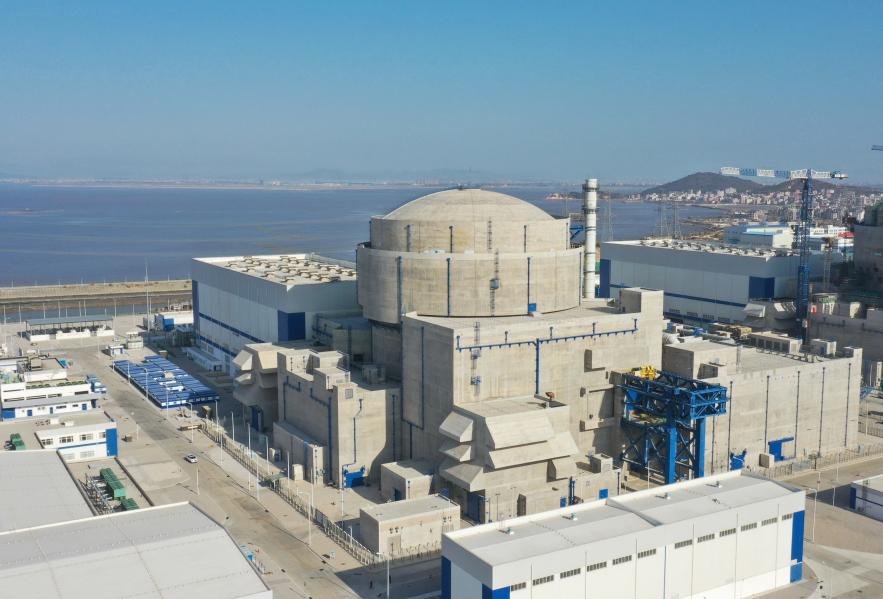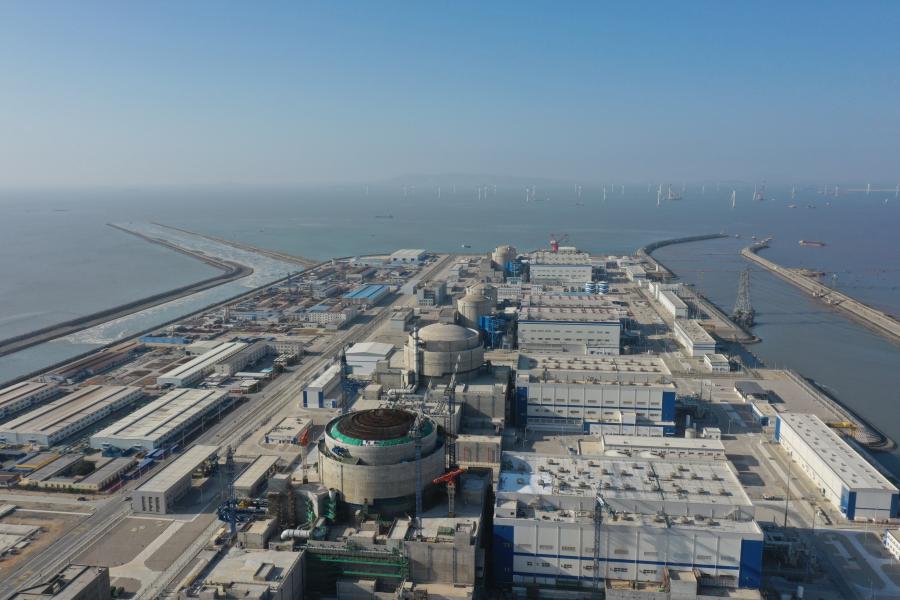-- The Hualong One reactor, with all of its core components produced domestically, has a design life of 60 years and meets the strictest safety standards in the world, according to the CNNC.
-- "With Hualong One online, China is now at the forefront of third-generation nuclear technology in the world, alongside countries like the United States, France and Russia," said CNNC Chairman Yu Jianfeng.
-- Commercial use of the reactor will help optimize China's energy structure in favor of low-carbon development.
by Xinhua writers Liu Yinglun, Gao Jing and Zhang Huaying
BEIJING, Jan. 30 (Xinhua) -- China's first nuclear power unit using Hualong One, a domestically designed third-generation reactor, entered commercial operations, paving the way for mass construction and export.
The No. 5 unit in the city of Fuqing in east China's Fujian Province began generating electricity for sale after a seven-day trial run, said the China National Nuclear Corporation (CNNC) on Saturday.
"With Hualong One online, China is now at the forefront of third-generation nuclear technology in the world, alongside countries like the United States, France and Russia," said CNNC Chairman Yu Jianfeng.
Commercial use of the reactor would help optimize China's energy structure in favor of low-carbon development, said Yu.
SAFETY FIRST
Safety is usually a massive concern for nuclear plants, only sharpened by Japan's 2011 Fukushima disaster. The Hualong One reactor has a design life of 60 years and meets the strictest safety standards in the world.
The reactor is complete with a combination of active and passive safety systems, double containment structure, as well as resistance against damage by the equivalent of a 9-magnitude earthquake, said Ye Qizhen, an academician of the Chinese Academy of Engineering.
The passive safety system, which relies on natural forces like gravity, provides an extra safety net for the reactor when all power supplies shut down in emergencies, said Ye. The double containment structure can defend aircraft impact from outside and seal radioactive substances inside, he added.
Hualong One units can avoid nuclear leakages and quickly restart operations, even in the extreme Fukushima circumstances where an earthquake coupled with a tsunami, said Yu.

Staff members work at the control room of the No. 5 nuclear power unit in the city of Fuqing, southeast China's Fujian Province, Jan. 30, 2021. (Xinhua/Lin Shanchuan)
Hualong One's refined safety mechanisms call for delicate day-to-day maintenance. Protocols for safety tests at Mao Yuankai's department of the No. 5 unit amount to around 500 booklets, up from roughly 400 for Fuqing's previous units.
Mao, 36, is one of the 44 control room operators at the No. 5 unit. Rotating three eight-hour shifts every day, they are the constant guardians against even the tiniest chance of jeopardy.
Clad in dark navy uniforms, Mao heads a team of six in the control room above the reactor, gazing into a few dozen semi-circle screens showing the unit's status. To defuse safety risks in daily operations, they are familiar with about 5,000 booklets of protocols and thousands of different alarms.
"I need to keep studying for as long as I live to handle possible emergencies better," said Mao.
HOMEGROWN TECH
Boasting 716 national patents and 65 international ones, over 200 overseas trademarks, and 125 software copyrights, Hualong One is China's homegrown model of the safer and more efficient third-generation reactor.
Hualong One's reactor core contains 177 fuel assemblies. The idea, first conceived in the late 1990s, remains the reactor's signature innovation.
The design can increase the unit's power by 5 percent to 10 percent while making it safer, said Liu Changwen, one of Hualong One's designers.
Hualong One also extended the refueling interval to 18 months, making it more cost-effective, according to Wu Lin, former vice president of the Nuclear Power Institute of China (NPIC).

Photo taken on Jan. 30, 2021 shows the No. 5 nuclear power unit in the city of Fuqing, southeast China's Fujian Province. (Xinhua/Lin Shanchuan)
To ensure all core components were produced domestically, 17 universities and research institutions, as well as 58 state-owned enterprises and over 140 private firms across China participated in Hualong One's development. The number of suppliers for the No. 5 unit topped 5,300 nationwide.
The steam generator, for example, is among the 411 core components domesticated for Hualong One. While they were mostly imported from countries like France and the United States before 2007, China's first patented model was created within 27 months by a team led by NPIC experts. It works as well as those in other third-generation power plants worldwide, if not better, said Wu.
Domestic steam generators have been adopted in Fuqing's No. 5 and No. 6 units, as well as the two Hualong One units under construction in Pakistan. A total of 12 are installed and another 12 are in the making.
Self-reliant core-component production will nurture China's high-tech manufacturing industry and make Hualong One reactors less prone to export restrictions, said Wu.
NUCLEAR FUTURE
Nuclear power is considered a clean energy source, promoted for global low-carbon development. Could Hualong One's step forward in commercial operations mean a step forward for China and the world in nuclear energy?
According to the CNNC, mass construction of the Hualong One reactor is in motion in China. In September 2020, China approved two new projects in Hainan and Zhejiang Provinces using Hualong One technology.
Hualong One reactor exports are supported by its comprehensive and self-reliant product standards that cover the reactor's full life cycle, said the CNNC.
With the largest nuclear power market globally, China is capable of providing services throughout the nuclear industry chain, said Yu.
"On the back of the commercial use and mass construction of Hualong One, China's nuclear industry will take up a larger share in the global market," said Yu.

Aerial photo taken on Jan. 30, 2021 shows a view of Fujian Fuqing Nuclear Power Co., Ltd., a subsidiary of the China National Nuclear Corporation (CNNC), in Fuqing, southeast China's Fujian Province. (Xinhua/Lin Shanchuan)
China vowed to peak carbon dioxide emissions by 2030 and achieve carbon neutrality by 2060. Experts say that the goals call for much more reliance on low-carbon alternatives like nuclear power.
Nuclear power can potentially take up as much as 20 percent of the country's energy structure, said Yu.
China had 49 working nuclear reactor units at the end of 2020. Nuclear power plants generated 366.24 billion kWh of electricity last year, accounting for 4.94 percent of the total power output, data from the China Nuclear Energy Association showed.
The No. 5 unit will likely generate nearly 10 billion kWh of electricity each year, potentially reducing carbon dioxide emissions by 8.16 million tonnes in annual terms, according to CNNC data. Enditem
(Video reporter: Lin Kai; Video editor: Zhang Yucheng)




